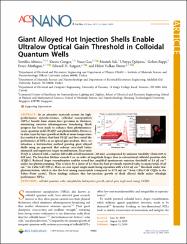Giant Alloyed Hot Injection Shells Enable Ultralow Optical Gain Threshold in Colloidal Quantum Wells

Göster/
Erişim
info:eu-repo/semantics/openAccessTarih
2019Yazar
Altintas, YemlihaGungor, Kivanc
Gao, Yuan
Sak, Mustafa
Quliyeva, Ulviyya
Bappi, Golam
Mutlugun, Evren
Sargent, Edward H.
Demir, Hilmi Volkan
Üst veri
Tüm öğe kaydını gösterÖzet
As an attractive materials system for high- Record-low optical gain threshold in giant-shell COWs performance optoelectronics, colloidal nanoplatelets (NPLs) benefit from atomic-level precision in thickness, minimizing emission inhomogeneous broadening. Much progress has been made to enhance their photoluminescence quantum yield (PLQY) and photostability. However, to date, layer-by-layer growth of shells at room temperature has resulted in defects that limit PLQY and thus curtail the 0.2 performance of NPLs as an optical gain medium. Here, we introduce a hot-injection method growing giant alloyed shells using an approach that reduces core/shell lattice mismatch and suppresses Auger recombination. Near-unity PLQY is achieved with a narrow full-width-at-half-maximum (20 nm), accompanied by emission tunability (from 610 to 650 nm). The biexciton lifetime exceeds 1 ns, an order of magnitude longer than in conventional colloidal quantum dots (CQDs). Reduced Auger recombination enables record-low amplified spontaneous emission threshold of 2.4 mu J cm(-2) under one-photon pumping. This is lower by a factor of 2.5 than the best previously reported value in nanocrystals (6 /kJ cm(-2) for CdSe/CdS NPLs). Here, we also report single-mode lasing operation with a 0.55 mu J cm(-2) threshold under two-photoexcitation, which is also the best among nanocrystals (compared to 0.76 mu J cm(-2) from CdSe/CdS CQDs in the Fabry-Perot cavity). These findings indicate that hot-injection growth of thick alloyed shells makes ultrahigh performance NPLs.

















